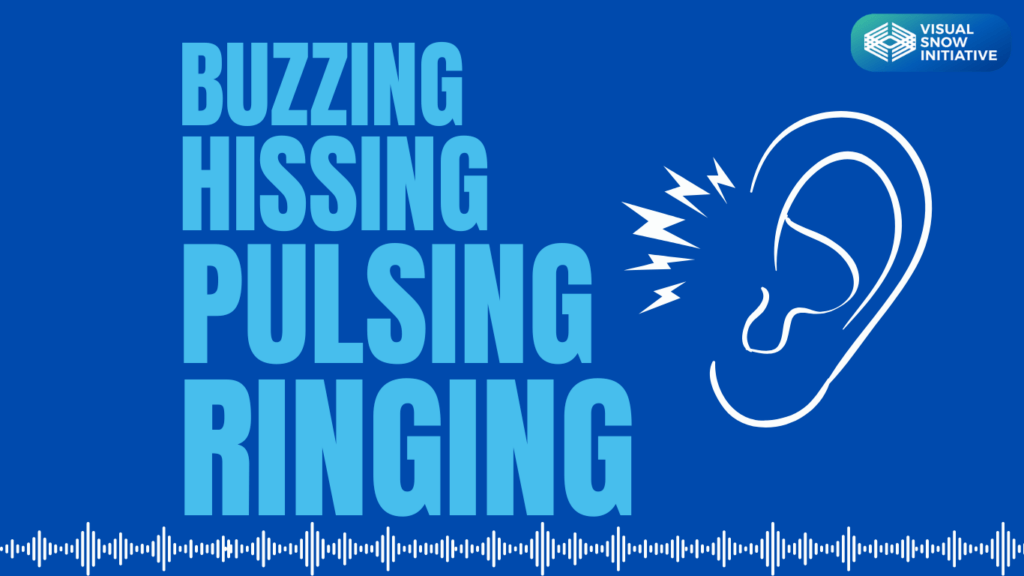Tinnitus Awareness Week 2024 (February 5th-February11th)
Imagine hearing a constant ringing in your ears; this is tinnitus, a condition affecting nearly 50 million Americans and more around the world. It is not just a simple ringing; it can be buzzing, hissing, and whistling. For about 20 million people, it is a chronic struggle, and 2 million endure extreme cases that significantly impact their lives.
Now, imagine not only hearing things others cannot but also seeing things that others do not. This is Visual Snow Syndrome (VSS), a neurological condition encompassing persistent visual static that covers the entire field of vision, along with additional visual & non-visual disturbances.
Clinically, Visual Snow might be to the visual system what tinnitus is to the auditory system. Both conditions show changes in neuronal activity in their respective brain structures. Like chronic tinnitus, visual snow does not respond well to typical treatments. Evidence reveals the two might be related, as many people with VSS also experience tinnitus. In fact, tinnitus is considered a common non-visual symptom of VSS.
Surprisingly, the high prevalence of tinnitus in VSS patients (63%) compared to the general population (7.9% with frequent tinnitus) suggests they may share some underlying mechanisms. A recent study from the University of Sydney compared brainwave activity in individuals with VSS (18 subjects in total) and found functional changes in the brains of VSS patients, with 16 out of 18 also experiencing tinnitus. The study also revealed changes in brain activity similar to those recorded in tinnitus subjects. The study suggests that therapies addressing tinnitus-related anxiety might also help for reducing the anxiety and discomfort caused by VSS symptoms.
Cortical oscillatory dysrhythmias in visual snow syndrome: a magnetoencephalography study
Visual Snow Syndrome and Its Relationship to Tinnitus
What Visual Snow May Tell Us About Tinnitus
Tips for Managing Tinnitus
Sound therapies
Exposure to sound can reverse neural changes, silencing tinnitus. Sound therapy may mask tinnitus sounds, aid habituation, or provide distractions.
- Tabletop or smartphone sound generators for relaxation or sleep: Placed near your bed, you can program a generator or set up a smartphone app to play pleasant sounds such as waves, waterfalls, rain, or the sounds of a summer night. You may also use other sound generators, such as a radio or a household fan. This will help you fall asleep.
- Hearing aids amplify external sounds, making tinnitus less noticeable.
- Wearable sound generators emit soft, pleasant sounds for continuous relief: Wearable sound generators are small electronic devices that fit in the ear, much like hearing aids and emit soft, pleasant sounds. As they are portable, these devices can provide continuous relief from tinnitus throughout the day.
- White noise sound machines help drown out tinnitus.
Other Therapeutic Interventions
Improves well-being by mitigating the impact of tinnitus and reduces anxiety through coping techniques, retraining the brain, and education about tinnitus.
- Counseling: Through counseling, you can learn coping techniques and strategies to avoid worsening symptoms, such as limiting exposure to loud noise.
- Cognitive Therapy: Teaches you how to identify negative thoughts that cause you distress. Your counselor will train you to change your response to negative thoughts and to focus on positive changes you can make to reduce the impact of tinnitus on your life. Evidence suggests this can alter dysfunctional neural pathways and “retrain” your brain to improve your condition, reducing the severity of primary and secondary symptoms.
- Tinnitus Retraining Therapy: Uses counseling and sound therapy to “retrain” the brain, both emotionally and physiologically, so you no longer notice your tinnitus.


